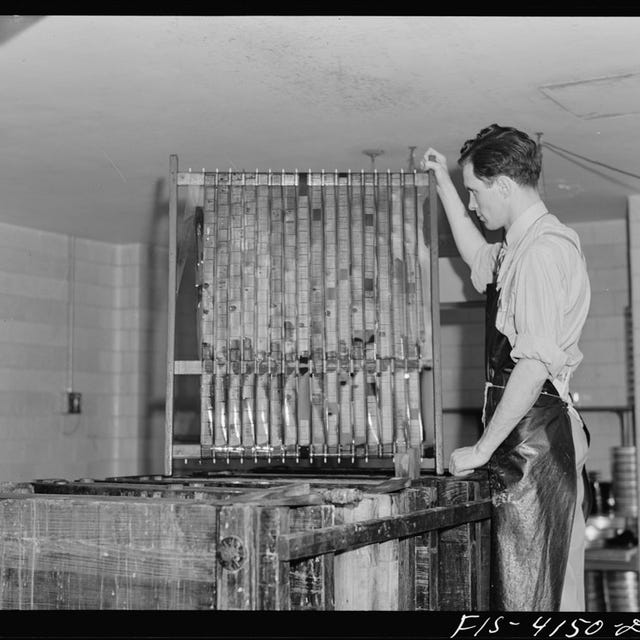While it’s possible to develop your own color film, black and white is a good place to start. It’s also the essence of film photography: just look at the work of Ansel Adams and Henri Cartier-Bresson. Pick up some Kodak Tri-X 400 or Ilford HP5 Super, load your old Nikon and go fire off a roll or two. While film processing isn’t rocket science, there is a learning curve, so don’t expect perfect results on your first try. – Jason Heaton
What’s old is new these days. Mechanical watches and vinyl records are on the rebound — and so are film cameras. Judging by the growing number of retro-styled digital cameras like the Fuji X100 and Nikon Df, buyers want to experience the tactile nature of the cameras of yore. But to go truly old school, you’ve got the ditch the SD cards, stop chimping at an LCD and load a roll of film. Fortunately, excellent vintage film cameras are cheap (for now) and film is still readily available. But film has to be processed before you can see what you’ve shot, and while there are still good photo labs in most major cities that will develop your rolls and give you back negatives, prints and a CD of digital scans, it can be expensive. For a generation reared on digital, the turnaround time can also seem interminable. But what shooting film lacks in instant gratification, it makes up for in satisfaction, especially if you learn to process and scan your own film — and it’s easier than you think.
Film photography is the process of exposing light-sensitive silver-coated acetate to light through your camera’s shutter and aperture. But that’s only half the story. To make those images on the film strip visible, they must be bathed in a developing chemical; that process is stopped with another chemical bath; finally a third mix of chemicals seals or fixes the images on the film. When you’re done, your roll of film is a roll of negative images which you can enlarge or digitally scan. The chemicals and minimal equipment required to process film can be found at most camera stores (usually on a dusty corner shelf) or ordered online. But first you’ve got to get the film out of the camera and off its roll.
Click to see Jason Heaton’s photo essay from Iceland, shot on film.
Darkrooms and Dark Bags
Contrary to popular belief, you don’t need a darkroom to process film. But you do need complete darkness when you remove the film from the roll. If you have a closet or room from which you can block out light completely, great, but if there’s even a sliver of light, you’ll ruin your film. The easier way to do it is using a dark bag, a large opaque nylon bag with sleeves for your arms, in which you can take the film off the roll and transfer it to the closed cylinder where the developing occurs. Whether you do this in a dark room or inside the bag, you’re operating blind and it can be tricky: you have to pry the plastic roll open, snip off the film leader and then thread the roll onto a reel and insert it onto the cylinder before you can switch the lights on. Practice makes perfect.
The Developing Tank
Once you get the film off the roll and in the developing tank, the hard part is over; the rest is high school chemistry class. The developing tank has an opening at the top in which you pour carefully measured developing fluid that has been diluted to a specific temperature and concentration. (This is all printed in the instructions with the developing kit and is specific to the type of film you’re using.) Once you pour the fluid into the tank, there is some swirling and inverting involved, and the timing is important lest you over-process the film. Then you’ll pour out the fluid, rinse with the stop bath (or water), then add the fixer and do the same thing over again. Roughly 15 minutes later you can take out your roll of negatives, hang them to dry and see how you’ve done.
Assess the Negatives
Look at the negatives through a loupe over a light source, being careful not to get fingerprints all over the strip. You can cut the negatives carefully into manageable lengths and store them in plastic sleeves for safe keeping. If you want enlargements directly from the negatives, you’re going to need a darkroom or you can have a lab print just the photos you choose. But if you want to share on social media, your best bet is to scan the negatives. Film scanners are affordable and very easy to use. Some are freestanding units with their own preview LCDs and will scan to a media card for easy transfer; others will connect to your computer so you can fine tune scanning parameters, edit the results and transfer directly to your hard drive. Whichever way you go, choose one with suitable scan resolution that will do your hard-earned photos justice. Scanning is as easy as fitting your negative strip into a carrier tray and running it through the scanner. Tweak your scanned files in iPhoto, Photoshop or other image editing software and you end up with digital files — ones to give you bragging rights, with rich contrast and grain that digital photos will never match.
Process the Film
Processing your own film doesn’t just make you self-sufficient from shooting to sharing — it also brings a satisfaction that comes with truly making a photo, in every sense of the word. It does take practice, so don’t be too hard on yourself if you don’t nail it on the first time, or even the third. Once you master the process, you’ll never visit a photo lab again. And your digital camera might start gathering dust.
NEXT UP


















